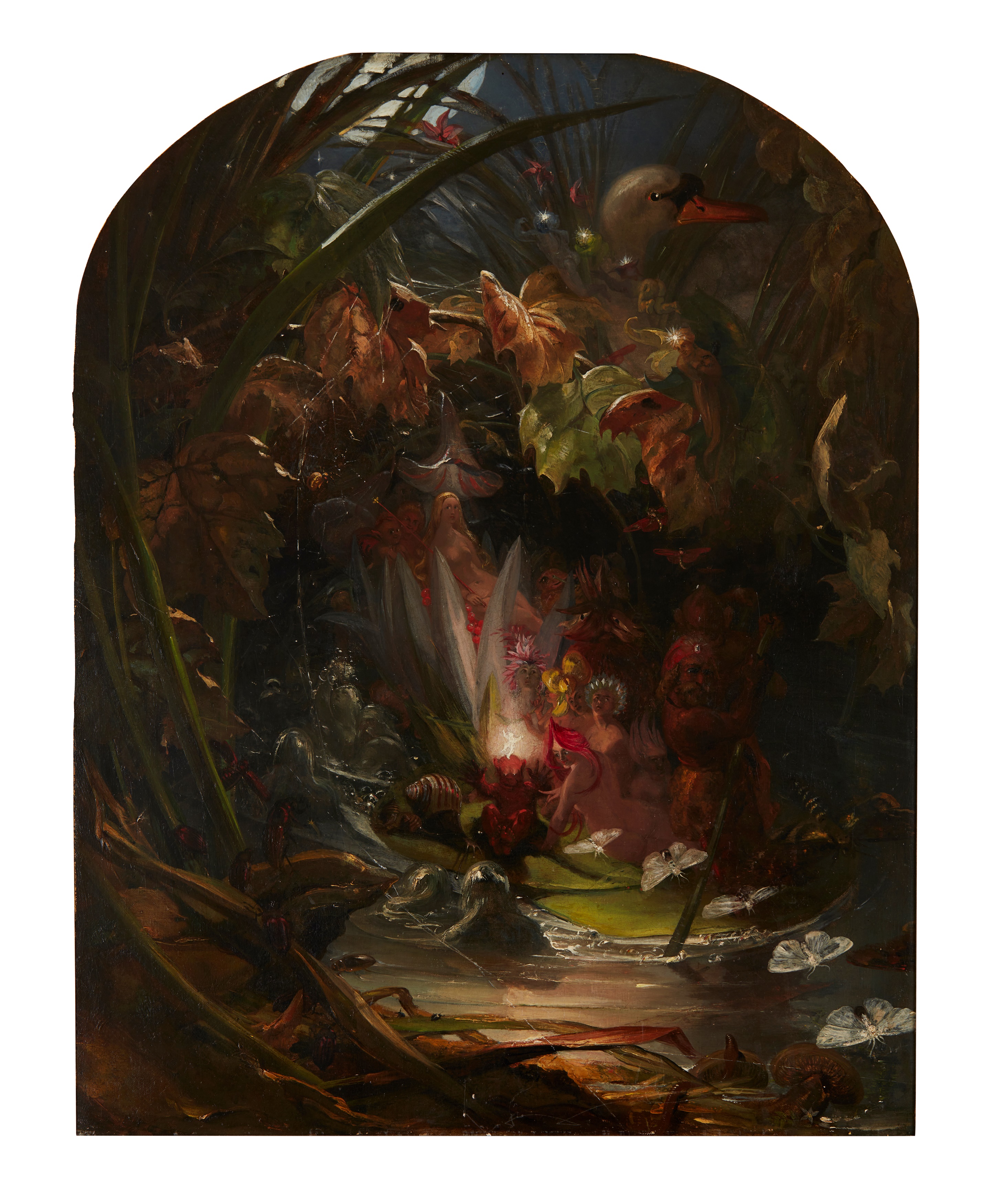WILLIAM BELL SCOTT H.R.S.A., L.L.D. (SCOTTISH 1811-1890)
THE BARGE OF THE FAIRY MAB
£20,160
Scottish Paintings & Sculpture
Auction: Evening Sale: 08 December 2022 | From 18:00
Description
Inscribed with title and address and 'Government School of Design' on a contemporary label verso, feigned arched top, oil on canvas
Dimensions
61cm x 51cm (24in x 20in)
Provenance
Provenance: Careston Castle, Brechin, Angus
Exhibited: Royal Scottish Academy, Edinburgh, Annual Exhibition, 1845, no.175
Footnote
O, then, I see Queen Mab hath been with you.
She is the fairies' midwife, and she comes
In shape no bigger than an agate-stone
On the fore-finger of an alderman,
Drawn with a team of little atomies
Athwart men's noses as they lies asleep;
Her wagon-spokes made of long spinners' legs,
The cover of the wings of grasshoppers,
The traces of the smallest spider's web,
The collars of the moonshine's wat'ry beams,
Her whip of cricket's bone; the lash of film…
— Mercutio in Romeo and Juliet, Act I, scene IV
William Bell Scott was born in Edinburgh in 1811, the son of the engraver Robert Scott (1777-1841) and younger brother of the painter and poet David Scott (1806-1849). He trained in fine art at the Trustees’ Academy, a forerunner of Edinburgh College of Art. In 1837 he moved to London, where he soon developed a connection with a group of painters known as ‘The Clique’ who met to sketch together. ‘The Clique’ was founded by the renowned fairy painter Richard Dadd in the late 1830s, and co-alesced around a rejection of high art and a belief that their work should not conform to academic ideals. Bell Scott formed a friendship with Dadd, and they collaborated on illustrations for Samuel Carter Hall’s ‘Book of British Ballads’ (1842). The group disbanded in 1843 after Dadd was diagnosed insane and institutionalised at Bethlem for killing his father during a psychotic breakdown.
In 1843 Bell Scott was offered the position of Master of the Government School of Design at Newcastle-upon-Tyne, where he would remain for the following twenty years. He nevertheless maintained a relationship with the Pre-Raphaelites in London, and contributed poetry to their journal ‘The Germ’. He was close to William Holman Hunt and, in particular, Dante Gabriel Rossetti, whose family championed his work.
Bell Scott is best-known for his history paintings. In 1854 he was commissioned to paint a series of works depicting the history of Northumberland for Wallington Hall, the Morpeth home of his most valued patron Lady Trevelyan. Five years later he met Alice Boyd of Penkill Castle, Ayrshire, while she studied in Newcastle. The relationship became close, and from the 1860s Scott lived with Alice Boyd and his wife Letitia in a ménage à trois between Scotland and London until the end of his life. Following her brother’s death in 1865 Alice became the owner of Penkill, and Bell Scott spent several years in the 1860s painting the staircase with a series of frescos illustrating James I’s poem ‘The Kings Quair’.
‘The Barge of the Fairy Mab’ was exhibited at the Royal Scottish Academy in 1845, and pre-dates Bell Scott’s Pre-Raphaelite associations. The Fairy Queen Mab is glimpsed through lily petals glowing in the moonlight, being transported on a barge formed from lily pads. Her hair falls in flowing golden tresses and she holds a long red wand, which she directs towards a spider spinning silken threads, as her wide eyes gaze upwards towards the web. The Fairy Queen and several of her attendants are unclothed, with a sensuous allure of form that could not have been freely expressed in a traditional Victorian genre or history painting. The intense jewel-like colour draws the eye towards the heart of the composition, as does the detailed rendering of the elf-like creatures, insects, bugs and leaves. Even the delicate threads of the web are beautifully illuminated. The scene is enclosed within leaves and grasses, through which fairies make their way, with bright star-like torches on their heads, past a swan nestled in the background. There is joy, humour and mischief in the rendering of Fairy Queen Mab and her entourage, and it is a delight to glimpse into this fantasy.
Queen Mab is a mischievous yet benevolent figure. In ‘Romeo and Juliet’ she is referred to as the fairies’ midwife, who delivers sleepers their innermost fancies in the form of dreams. In Victorian Britain a great fashion for fairy painting co-incided with a resurgence of interest in Shakespearean plays such as ‘The Tempest’ and ‘A Mid-Summer Night’s Dream’, in which fairies feature as characters. The popularity of the fairy genre is seen as a reaction to the societal and environmental changes being wrought by industrialisation and the expansion of the suburbs. Viewers sought escapism from the changing world through mystical, spiritual and fantastical scenes and images of the natural world. The fairy genre is rare in Bell Scott’s oeuvre, yet in ‘The Barge of the Fairy Mab’ he has created a charming example of Victorian fairy painting at its best.

